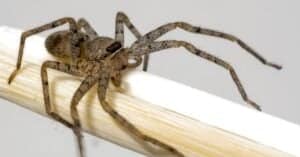Spiders are famous for having eight eyes, but what about their ears? Spiders are one of the oldest living land animals. Recently, new insights have been coming to light about how these arachnids have been surviving for the last 400 million years. It turns out a big part of their survival strategy relies on sound.
Once thought to only be able to pick up on surface vibrations, it’s now clear spiders can detect airborne sounds. Sometimes spiders can even “hear” you from across the room. However, it’s not the same type of hearing we experience with our ears. In the insect world, things are always a bit more complex. Follow along as we discover how these eight-legged creatures experience sound.
Do Spiders Have Ears?
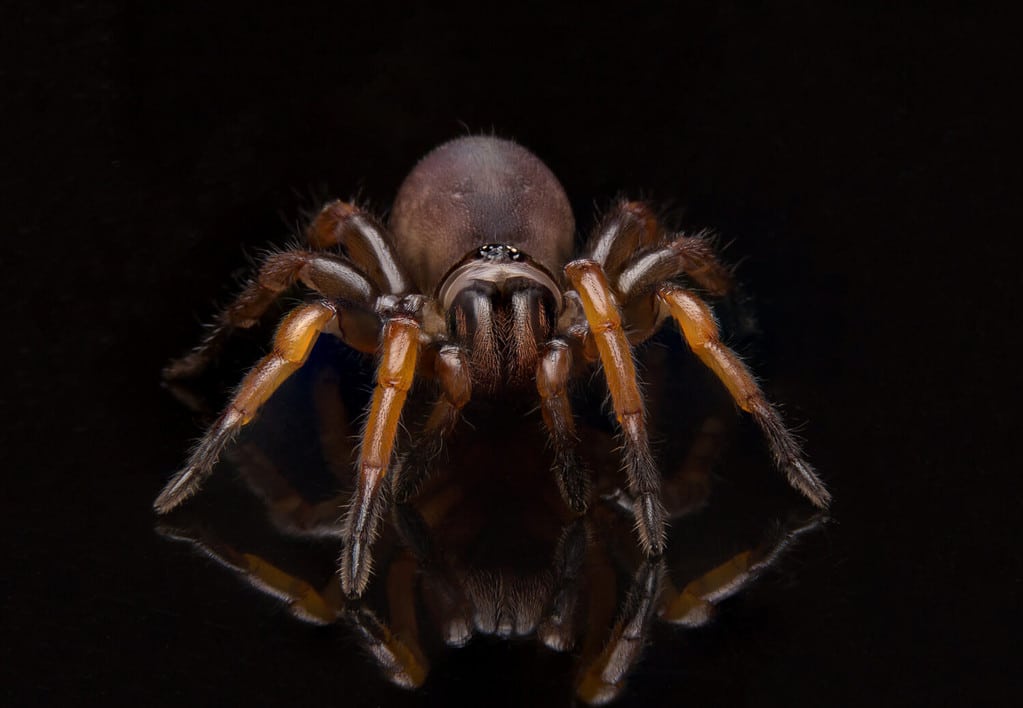
Spiders don’t have ears but they can still detect sound-based vibrations.
©Pichit Sansupa/Shutterstock.com
No, spiders don’t have ears, but they can still pick up on sounds. Spiders can pick up sounds thanks to long sensitive leg hairs (trichobothria). For a long time, it was believed that these sounds had to travel through surface vibrations. But now it’s clear, that some spiders can detect sounds in the air. A recent Cornell study shed light on the fact that jumping spiders are able to detect airborne sounds. This airborne listening skill helps them sense far-away sounds and from all sorts of positions.
Jumping spiders are especially sensitive to sounds from 80 to 130 Hz. It’s no mistake that their hearing range includes sounds as low as 80 Hz. This is the same sound range as mud dauber wasps’ wings, the jumping spider’s top predator.
Can Spiders Hear?
Yes, spiders can hear. Spiders don’t have developed ears like a grasshopper does, but they can still sense sounds. Instead of eardrums, they use tiny sensitive hairs to detect vibrations. The leg hair connects to nerve cells. When the hairs move in response to airborne vibrations, the spider feels the sound. If a wasp, a common enemy of the spider, is flying nearby, the spider can feel the air vibrations.
Tricobothria: Highly Sensitive Leg Hairs
Let’s break down exactly how spiders “hear” with their leg hairs. The vertical leg hairs, or trichobothria, rest at the upper surface of the spider’s outermost limbs. This special position gives the hairs an advantage of sticking out a bit since they’re right by the spider’s liming “joint” or “hinge”. The highly sensitive trichobothria can then pick up on air vibrations from any direction.
How Do Spiders Feel Surface Vibrations?
Spiders have vibration sensors spread out on all of their legs. And these organs have different ways of interpreting sound. These vibration sensors are referred to as lyriform or slit organs. These sound-sensing organs are incredibly intricate.
If a bug lands on the web, the spider’s limbs sway slightly. This puts a specific type of strain on the slit organs, which lets the spider know it’s time to eat. But if the spider’s limbs are swaying because it’s a windy day, they can tell the difference. They can even sense when their vibrational organs are picking up on a nearby mate. The surface vibrations a spider picks up on can come from nearby their web, plants they’re resting on, and water too.
Webs Help Orb-Weaving Spiders Listen
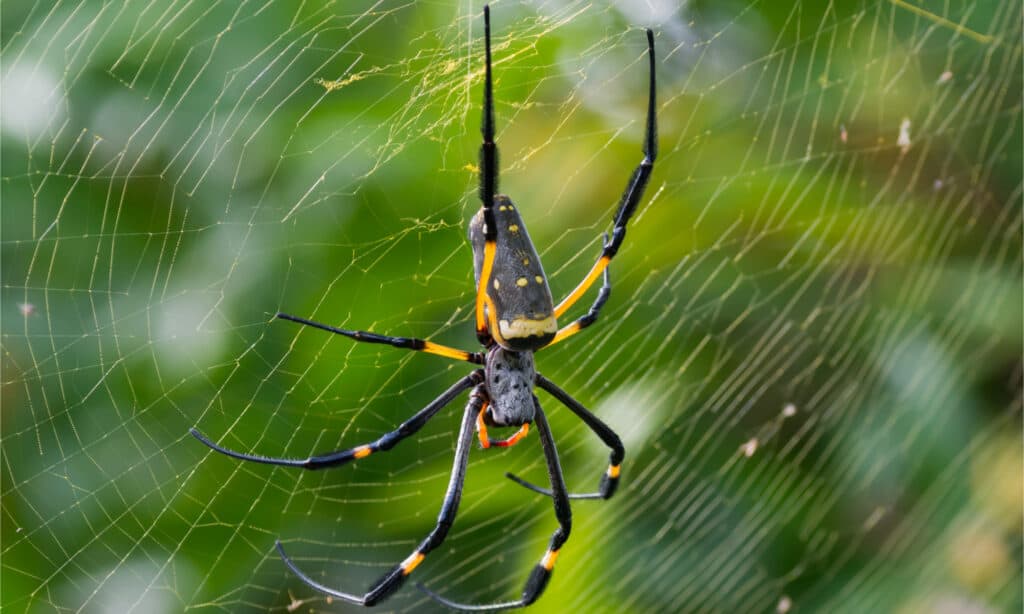
Golden orb-weavers spin massive webs that serve as an acoustic sounding board.
©Dave Montreuil/Shutterstock.com
Webs do more than catch bugs. They also help spiders sense sounds. This is especially true for the orb-weaver spider, whose large web serves as both an instrument and an eardrum.
Orb-weaver spiders are famous for making webs that are 10,000 times larger than themselves. They weave these impressive homes with sound-sensitive silk. Known for their quick response to movement, the fibers act like a giant acoustic antenna. This helps the orb weaver pick up on even the tiniest movements.
To sense the vibrations, the orb-weaving spider uses sensory organs on its tarsal claws. The tarsal claw is on the very tip of their legs and contains sensory organs. Along with picking up movement, this claw also helps the spider grasp the web so it can move around.
Spiders Can Tune Webs Like Instruments
Orb weaver spiders can also tune their web as if it were a musical instrument. This lets the orb-weaver adjust the acoustic antenna so they can detect specific sounds and different frequencies. One way spiders tune or change a strand’s tension is by changing their body position. So if you see an orb-weaver spider crouching or stretching, it might be tuning its web.
The amazing tuning abilities don’t stop there. Orb-weavers can also change the sound a strand makes. This is similar to how a musician can alter pitch by tightening or loosening the string of an instrument. By tightening and or loosening the silk strands, the spider can change the way the string reacts to sound. In a way, it’s like they’re changing the pitch. These adjustments help the spider get more information about what’s happening in and around their web.
Another fun fact is that orb-weavers can play their webs to feel the vibrations. This is a lot different than the sit-and-wait approach many spiders make. When they’re ready to play their web, they choose a specific string and pluck it with their tarsal claw. Then they can interpret what the different vibrations mean and take appropriate action. Sometimes the vibration alerts them to a tasty snack caught in the silk strands. Other times it might let the spider know about debris clogging up its web.
Jumping Spiders Hear Across Rooms

A jumping spider can hear your voice across the room.
©pratan ounpitipong/Shutterstock.com
Do jumping spiders freak you out a bit? Well, things are about to get a bit more freaky. Not only are jumping spiders super fast and sneaky, but they can also hear you from across the room. Thankfully, these little critters aren’t interested in listening in on your conversations. Instead, they’re more concerned with finding food and avoiding predators.
Tiny jumping spiders can also sense sounds over 9 feet away, a distance of over 100 times their body length. If a jumping spider thinks it hears a nearby wasp, it’ll immediately freeze to avoid detection. But if the wasp is far away, they know they’re safe.
Ogre-Faced Spiders Hear With Their Legs
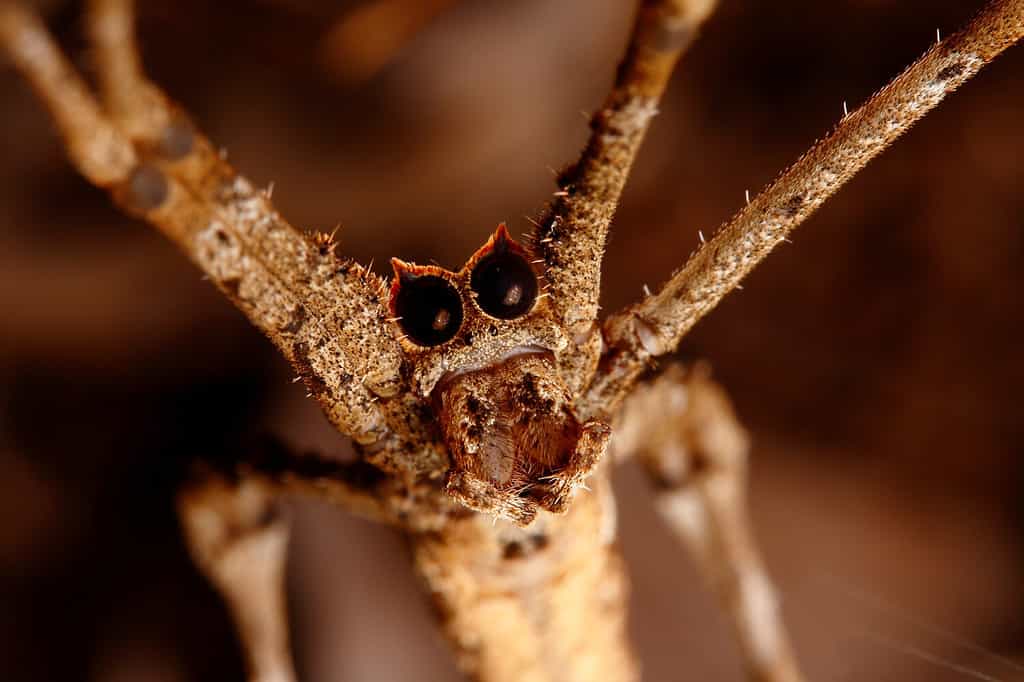
The type of sound an ogre-faced spider senses determines how it responds.
©Ondrej Michalek/Shutterstock.com
New research suggests ogre-faced spiders can sense a wide range of sounds with leg-based sensory organs. They can even pick up on faraway sounds over 6 feet away. The type of sound an ogre-faced spider picks up will determine how it reacts.
Low-frequency sounds that mimic the sound of prey usually result in a backward movement. Whereas dangerous high-frequency sounds make them stop moving altogether. This type of “freezing” behavior helps the spiders stay safe when hungry birds are around.
Ogre-faced spiders may be also capable of directional hearing, or being able to tell where sound is coming from. This ability would make these already skilled hunters all the more successful. Which could explain how they’re so good at making aerial strikes.
Spiders Are the Second Most Vibration-Sensitive Organism
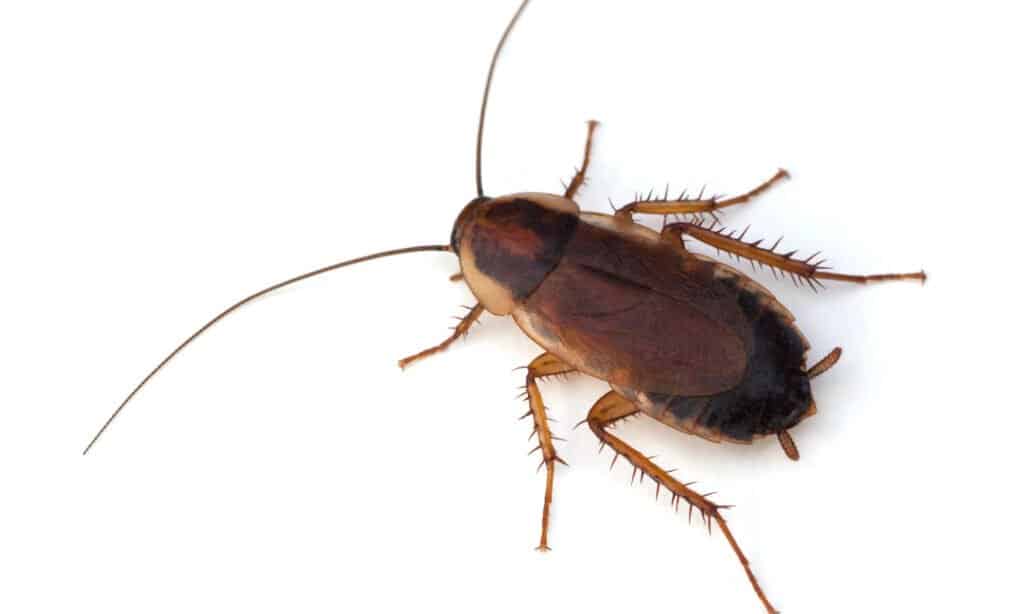
Spiders and cockroaches are two of the most vibration-sensitive organisms.
©Melinda Fawver/Shutterstock.com
Cockroaches are the most vibration-sensitive organisms, with spiders being the second. New research, led by Clemens F. Schaber of the University of Vienna’s Department of Neurobiology, confirms this ranking.
Spiders pick up on surface vibrations coming from plants, webs, or whatever they’re standing on. And they can tell what the vibration is alerting them to based on its frequency and volume. If everything lines up, the vibration sends out the message, “There’s food here!”. But if it’s a frequency the spider isn’t familiar with, they’ll hold off their attack.
Do Spiders Make Sounds?
Spiders can experience sounds, but can they make them? Spiders are known for being sneaky, silent creatures. But this isn’t always the case. Some species make noises as a warning or to find a mate. There are also a couple of species, like wolf spiders and tarantulas, that can make sounds humans can hear.
Wolf Spiders Purr
The wolf spider makes a low purring sound to attract a mate. Instead of using an organ to make the noise, the spider “plays” the sounds on nearby objects.
Wolf spiders purr by rubbing their arm-like limbs or pedipalps together. One pedipalp is rough, and the other is designed to scrape. When you put them together they can make some pretty strong vibrations. These vibrations bounce off nearby objects, like dead leaves, to produce the purring sound. So, the purring is really coming from the rustling of the vibrating leaves.
Australian Tarantulas Whistle
When threatened, Australian wolf spiders live up to their name by emitting a whirring whistle. Sometimes the noise sounds a bit like a bark. The spider makes this sound by rubbing hairs on their mouth part. They rub rows of modified spines on their front pair of sensory organs against opposing spines on their jaw. This trick is known as stridulation. The opposite spines are the stridulating organ. Being able to whistle comes in handy when the tarantula needs to scare off a hungry predator.
What Type of Music Do Spiders Like?
What type of music are spiders fond of? It turns out it’s not techno or rap, but rather classical tunes like Bach.
Spiders can respond to music, and research suggests they even have musical preferences. In one study, scientists observed how spiders spun their webs in response to music. The spiders they played techno for spun their webs as far away from the speaker as possible. But when they played classical tunes, the spiders stayed nearby. There are also studies where classical music encourages spiders to build more symmetrical webs.
Historically, there have been accounts of spiders falling in love with music. In a 1935 book by WW Froggart called “Australian Spiders and their Allies,” there are a couple of stories about spiders in history. One excerpt talks about how spiders would come when a Paris prisoner would play his lute. Another excerpt mentions a prisoner attracting spiders by playing a bagpipe.
Tarantulas Love Silence
If a tarantula had to choose between classical music and silence, they’d choose the latter. Tarantulas like dark, quiet spaces. That’s because these spiders are highly sensitive to sounds that they pick up on through vibrations.
If you can hear something, a tarantula can feel like. Because they feel sounds through their body, loud vibrations are upsetting. Many tarantula owners have found that their hairy pet is much happier when they have peace and quiet. A quiet location helps minimize the vibrations the tarantula feels, which can reduce stress levels.
What Insects Can Hear?

Just like grasshoppers, crickets can hear sounds through their knee-ears.
©iStock.com/Florian DENIS
Insect orders that can detect sounds include Orthoptera, Homoptera, Heteroptera, Lepidoptera, Diptera, and some Arachnids. In the Orthoptera, the insect has well-developed ears so the ability to hear sound is advanced. However, the ears aren’t always located on the insect’s head. For instance, grasshoppers and crickets listen to the world through their knee ears.
The photo featured at the top of this post is © Arif Supriyadi/Shutterstock.com
Thank you for reading! Have some feedback for us? Contact the AZ Animals editorial team.





